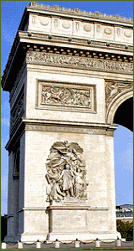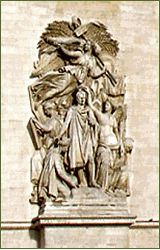|
The work was taken over by Huyon, after the architect and
designer, Jean Chalgrin, died in 1811. Unfortunately construction was halted and would not
be completed until the reign of King Louis-Philippe, in 1833 to1836. This was under
the direction of Hericart de Thury and the architects on site were Goust then Huyot.
The sculpture representing Peace is now interpreted as commemorating the Peace of 1815,
which was not the original intention.
The Astylar design in the Neoclassical version of ancient Roman architecture is by Jean
Chalgrin. Major academic sculptors of France are represented in the sculpture of the
Arc de Triomphe, namely Cortot, Rude, ?tex, Pradier and Lemaire. And the main
sculptures are treated as independent trophies applied to the vast masonry masses.
The four sculptural groups at the base of the Arc de
Triomphe are the triumph of 1810 by Jean-Pierre Cortot, Resistance and Peace, both by
Antoine Etex.
The most renowned of them all, the Departure of the Volunteers, which is commonly called
La Marseillaise, is by Francois Rude. And it was the face of the allegorical
representation of France calling forth her people on this last sculptural group that was
used as the belt buckle for the seven-star rank of Marshal of France.
In the attic above the richly sculptured frieze of soldiers are 30 shields engraved with
the names of major revolutionary and Napoleonic military victories.
The inside walls of the monument list the names of 558 French generals with the names of
those who died in battle being underlined. Also inscribed on the shorter sides of
the four supporting columns, are the names of the major battles of the Napoleonic
wars. Yet the battles that took place in the period between the departure of
Napoleon from Elba and his final defeat at Waterloo are not included.
The sword carried by the Republic in the Marseillaise relief broke off, apparently on the
day that the Battle of Verdun began in 1916. Tarpaulins to conceal the accident, and
to avoid any undesired or ominous interpretations, were immediately put in place to hide
the problem.
Beneath the Arc is the Tomb of the Unknown Soldier from the First World War and France
took the example from the Unknown Warrior in Westminster Abbey in the United Kingdom.
It was originally decided in November 12, 1919 to bury the unknown soldier's remains in
the Pantheon, but a public letter-writing campaign led to the decision to bury him beneath
the Arc.
Interred on Armistice Day 1920, it has the first eternal flame lit in Western Europe since
the Vestal Virgins' fire was extinguished in the year 391 and it burns in memory of the
dead who were never identified, now in both World
War I and World War II.
The coffin was put in the chapel on the first floor of the Arc on 10 November 1920, and
put in its final resting place on 28 January 1921. The slab on top carries the
inscription "Here lies a French soldier who died for his fatherland 1914-1918".
A ceremony is held there every year on 11 November on the anniversary of the armistice
which was signed between France and Germany in 1918.
There are many famous victory marches that have past the Arc de Triomphe and include the
Germans in 1871, the French in 1918, the Germans in 1940, and the French and Allies in
1944 and 1945.
|
|



